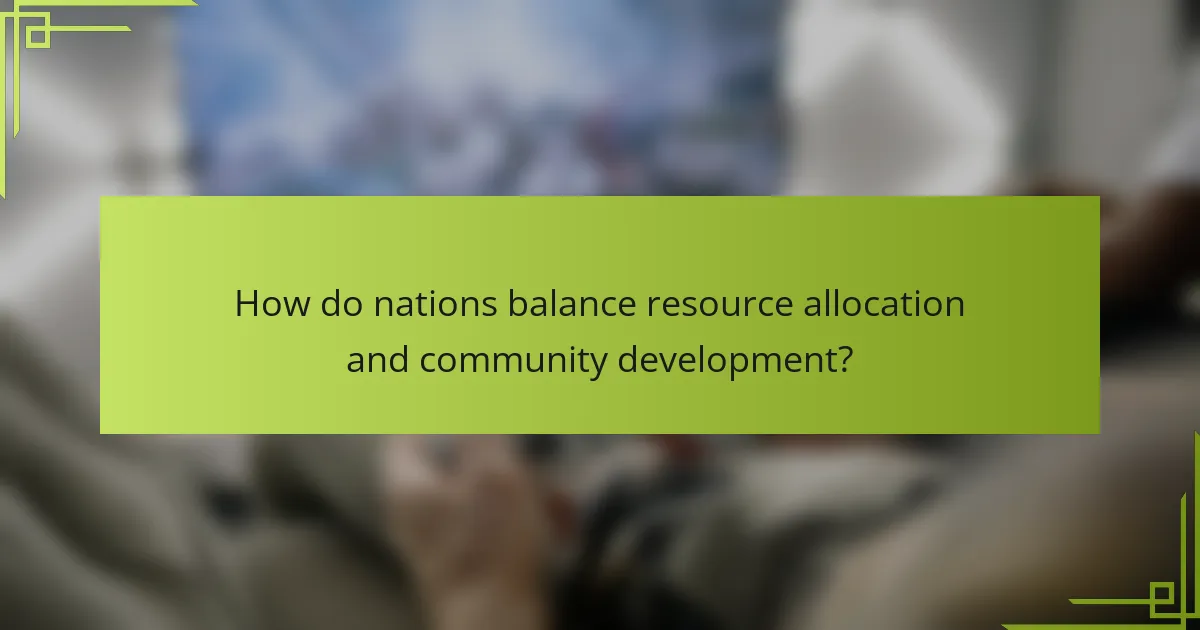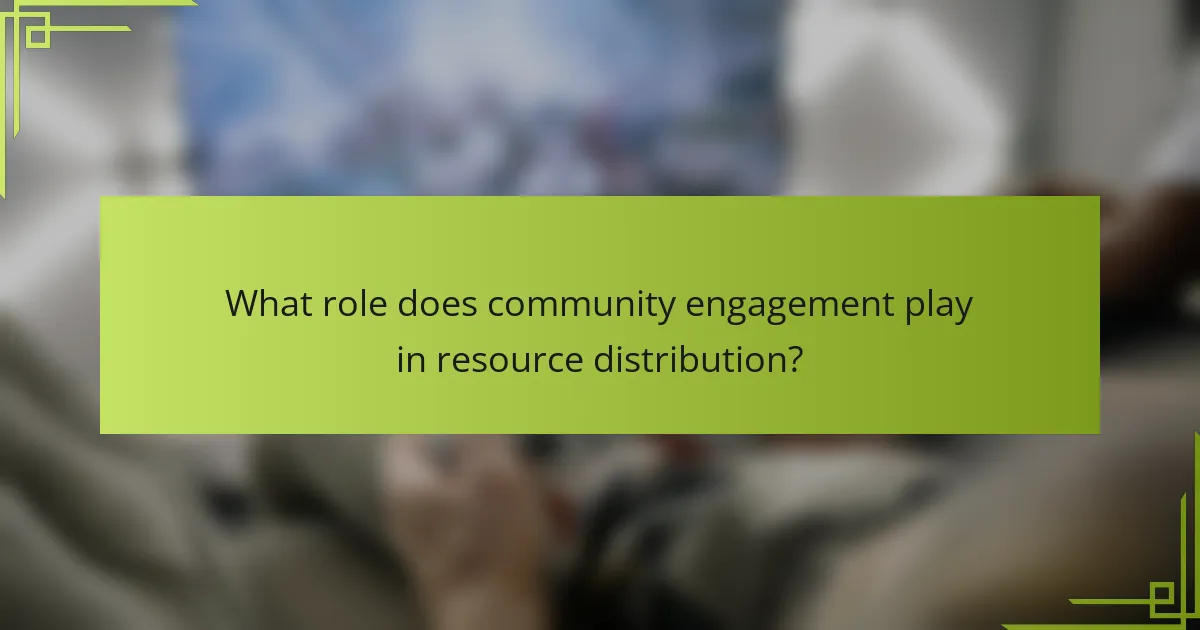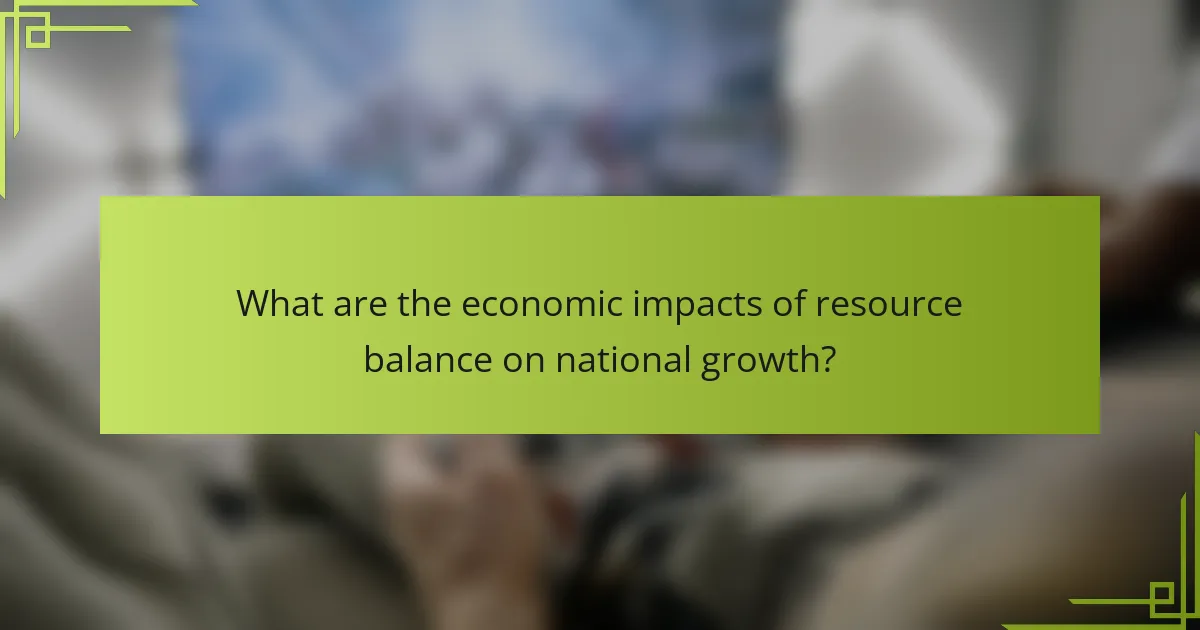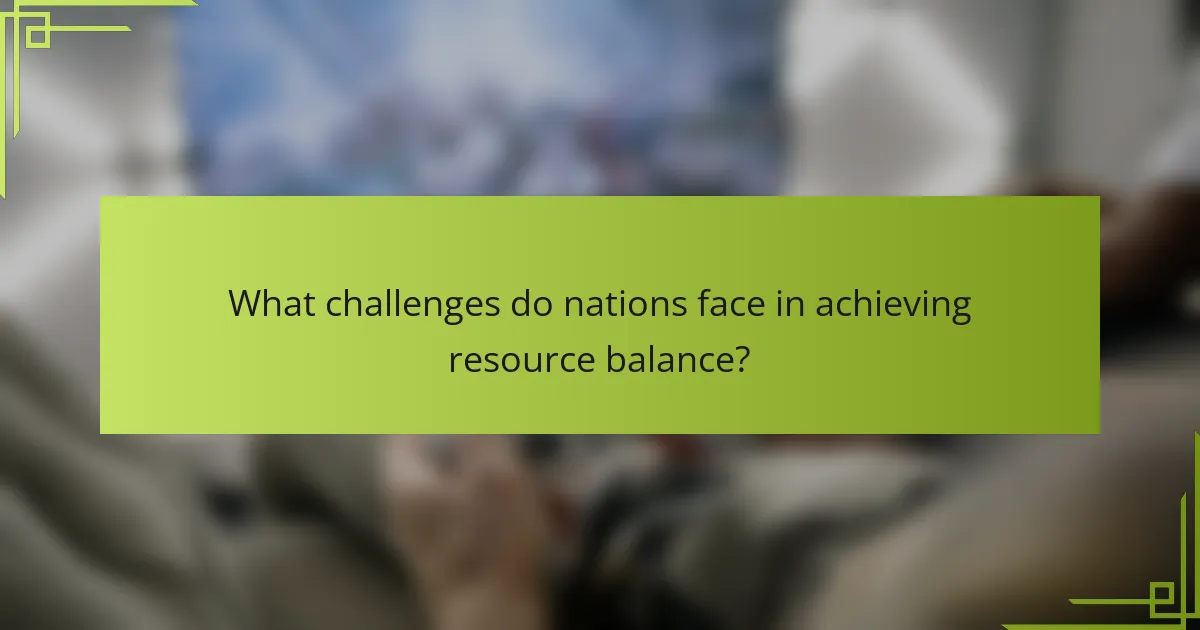Balancing resources and community growth is crucial for national prosperity. Effective governance ensures equitable distribution and fosters sustainable development. Engaging communities in decision-making enhances resource allocation and addresses local needs. Innovative technologies and cultural factors further shape resource management strategies, influencing economic stability and social cohesion.

How do nations balance resource allocation and community development?
Nations balance resource allocation and community development by strategically prioritising investments. Effective governance ensures equitable distribution while fostering sustainable growth.
Governments assess community needs, allocate budgets to essential services, and promote public-private partnerships. For instance, infrastructure projects enhance accessibility, driving economic development.
Data shows that nations investing in education yield higher long-term returns. A study found that every dollar spent on education can generate up to ten dollars in economic growth.
Engaging communities in decision-making fosters trust and improves outcomes. This participatory approach leads to tailored solutions that address unique local challenges.
What are the key resources that influence national growth?
Key resources influencing national growth include natural resources, human capital, infrastructure, and technology. Natural resources provide essential materials for industries and energy. Human capital enhances productivity through education and skills. Infrastructure supports economic activities and connectivity. Technology drives innovation and efficiency.
Which strategies enhance sustainable resource management?
Effective strategies for enhancing sustainable resource management include community engagement, integrated planning, and technology adoption. These approaches ensure resources are utilised efficiently while fostering community growth.
Community engagement fosters local participation in decision-making, leading to more tailored and accepted resource management practices. Integrated planning connects environmental, economic, and social aspects, promoting holistic resource use. Technology adoption introduces innovative solutions, such as data analytics, to optimise resource allocation and minimise waste.
As a result, these strategies create a balanced approach to resource management, aligning community needs with sustainable practices.

What role does community engagement play in resource distribution?
Community engagement significantly enhances resource distribution by fostering collaboration and trust among stakeholders. Engaged communities can identify their unique needs, ensuring resources are allocated effectively. This participatory approach leads to more equitable distribution and promotes sustainable growth. For instance, when residents actively participate in planning, they can prioritise essential services, leading to improved outcomes. Additionally, community input can uncover rare attributes of local contexts that may otherwise be overlooked, further optimising resource allocation.
How can communities effectively advocate for their resource needs?
Communities can effectively advocate for their resource needs by organising collective efforts, engaging local stakeholders, and leveraging data to support their case. Building strong networks fosters collaboration and amplifies voices.
Utilising social media and public forums increases visibility for resource needs. Communities can present compelling narratives that highlight the impact of resource allocation on growth and well-being.
Establishing partnerships with local organisations enhances credibility and resource access. These alliances can mobilise additional support and facilitate resource-sharing initiatives.
Regularly assessing community needs ensures that advocacy efforts remain relevant. Gathering feedback helps shape strategies that resonate with both community members and decision-makers.
Which models of community participation yield the best results?
Community participation models that prioritise collaboration and resource-sharing yield the best results in “Rise of Nations.” These models enhance community growth and resource management.
Effective models include participatory budgeting, which encourages citizen input on resource allocation, and community-driven development, fostering local leadership. Additionally, leveraging digital platforms for engagement can significantly increase participation and transparency.
Research indicates that communities utilising these models see improved satisfaction and a stronger sense of ownership among members. For instance, participatory budgeting has shown to increase public investment effectiveness by aligning projects with community needs.
In summary, models that emphasise collaboration and transparency lead to enhanced outcomes in resource management and community growth.

What are the economic impacts of resource balance on national growth?
Resource balance significantly influences national growth by optimising resource allocation and enhancing productivity. Effective management of resources leads to sustainable economic development, increased investment, and improved living standards. For instance, countries with balanced resource distribution often experience lower unemployment rates and higher GDP growth.
Furthermore, resource balance fosters innovation, as communities can invest in technology and infrastructure. This creates a ripple effect, stimulating various sectors and attracting foreign investments. As a result, nations can achieve long-term economic stability and resilience against global market fluctuations.
In summary, the economic impacts of resource balance on national growth are profound, driving efficiency, innovation, and overall prosperity.
How do resource disparities affect economic stability?
Resource disparities significantly undermine economic stability by creating unequal opportunities for communities. Areas with abundant resources often experience growth, while those lacking essential resources face stagnation.
Disparities can lead to increased unemployment rates, reduced access to education, and limited healthcare services, further entrenching poverty. For example, regions rich in natural resources attract investments, enhancing infrastructure and job creation. Conversely, resource-poor areas struggle to attract capital, leading to economic decline.
As a result, balancing resource distribution is crucial for fostering equitable community growth. Ensuring access to resources can promote overall economic stability and enhance quality of life across diverse regions.
What are the long-term benefits of equitable resource allocation?
Equitable resource allocation leads to sustainable community growth and improved quality of life. Long-term benefits include enhanced social cohesion, reduced inequality, and increased economic resilience. Communities that prioritise equitable distribution often experience lower crime rates and better health outcomes. This approach fosters innovation and collaboration, creating a more robust foundation for future development. As a result, equitable resource allocation becomes a catalyst for lasting positive change.

How do cultural factors influence resource management in different nations?
Cultural factors significantly shape resource management strategies across nations. These influences include values, traditions, and social norms that dictate how communities prioritise resource allocation and sustainability.
For instance, collectivist cultures often emphasise communal resource sharing, leading to cooperative management practices. In contrast, individualistic societies may focus on personal ownership, resulting in competitive resource utilisation. Additionally, cultural attitudes towards environmental stewardship can affect policies on conservation and sustainable practices.
The economic context also plays a role. Nations with rich cultural heritage may integrate traditional ecological knowledge into modern resource management, enhancing resilience and adaptability. Conversely, rapidly industrialising nations might prioritise economic growth over cultural preservation, impacting long-term resource sustainability.
In summary, cultural factors create diverse frameworks for resource management, influencing community growth and environmental health in distinct ways.
Which cultural practices enhance community resilience?
Cultural practices that enhance community resilience include collective decision-making, traditional knowledge sharing, and community rituals. These practices foster social cohesion and resource management.
Collective decision-making empowers communities to address challenges collaboratively, leading to stronger governance. Traditional knowledge sharing preserves valuable skills and insights, ensuring sustainable practices are passed down through generations. Community rituals, such as festivals and gatherings, strengthen bonds and promote a sense of belonging, which is vital during crises.
As a result, these cultural practices create a robust support network, enabling communities to adapt and thrive amid change.
How do local traditions shape resource utilization?
Local traditions significantly influence resource utilisation by aligning community practices with environmental sustainability. These traditions often dictate how resources are harvested, shared, and conserved. For instance, indigenous practices frequently emphasise respect for natural cycles, leading to sustainable farming and fishing methods. As a result, communities benefit from enhanced resource longevity and ecological balance. Ultimately, local traditions foster a cooperative approach to resource management, ensuring that community growth does not compromise environmental health.

What challenges do nations face in achieving resource balance?
Nations face significant challenges in achieving resource balance, including economic disparities, environmental degradation, and political instability. Economic disparities hinder equitable resource distribution, while environmental degradation threatens sustainability. Political instability disrupts governance and resource management, complicating efforts to balance community growth with resource availability. Effective collaboration and innovative policies are essential for overcoming these challenges.
Which external factors complicate resource management?
External factors complicating resource management include economic fluctuations, environmental changes, technological advancements, and social dynamics. These elements create challenges in balancing resource allocation and community development. For example, economic downturns can reduce available resources, while environmental issues may necessitate shifts in resource management strategies. Social dynamics, such as population growth or migration, can further strain existing resources, demanding adaptive management approaches.
How can nations overcome common barriers to resource equity?
Nations can overcome common barriers to resource equity through collaborative policy-making and innovative resource management. By fostering partnerships among governments, businesses, and communities, they can ensure fair distribution of resources. Effective strategies include implementing transparent governance, investing in infrastructure, and promoting sustainable practices. For example, countries can adopt inclusive economic models that prioritise marginalised communities. As a result, equitable access to resources can drive community growth and national development.

What innovative technologies are transforming resource management?
Innovative technologies are transforming resource management through data analytics, automation, and sustainability practices. These advancements enhance efficiency and support community growth.
Data analytics allows organisations to monitor resource usage in real-time, optimising allocation. Automation streamlines processes, reducing waste and improving productivity. Sustainable practices, such as renewable energy integration, promote long-term environmental health while meeting community needs.
For instance, smart grids utilise IoT technology to manage energy distribution efficiently. Similarly, precision agriculture employs drones and sensors to maximise crop yields while conserving water and soil resources.
These technologies collectively foster a balance between resource management and community development, ensuring that growth is sustainable and equitable.
How do digital tools improve transparency in resource allocation?
Digital tools enhance transparency in resource allocation by providing real-time data and analytics. These tools allow stakeholders to track resource distribution, ensuring accountability and informed decision-making. For example, platforms that visualise budget allocations can reveal discrepancies and promote equitable resource distribution. This transparency fosters trust within communities, encouraging participation in governance and development initiatives.
Which emerging technologies support sustainable community growth?
Emerging technologies such as renewable energy, smart infrastructure, and data analytics support sustainable community growth. These technologies enhance resource management, reduce environmental impact, and improve quality of life.
Renewable energy sources, like solar and wind, provide clean power while decreasing reliance on fossil fuels. Smart infrastructure, including IoT devices, optimises resource use and enhances urban planning. Data analytics enables communities to make informed decisions based on real-time information, fostering resilience and adaptability.
The integration of these technologies not only promotes sustainability but also encourages economic development and social equity, creating a balanced approach to community growth.

What lessons can be learned from successful nations in balancing resources?
Successful nations balance resources by prioritising sustainable practices, equitable distribution, and community engagement. These strategies foster economic stability and social cohesion. For example, Scandinavian countries emphasise renewable energy and social welfare, resulting in high quality of life and low inequality. Additionally, nations like Japan focus on efficient resource management, promoting innovation and resilience. As a result, these lessons highlight the importance of integrating environmental, economic, and social dimensions for holistic growth.
Which case studies exemplify effective resource management?
Case studies illustrating effective resource management include various strategies in “Rise of Nations.” The game emphasises balancing economic growth with community needs.
One notable example is the allocation of resources like food and gold, which directly impacts population growth and city expansion. Efficient management leads to sustainable development, showcasing the importance of resource prioritisation.
Another case involves strategic trade agreements with neighbouring nations, enhancing resource availability and fostering alliances. This demonstrates how collaboration can optimise resource use and community growth.
Lastly, the implementation of technological advancements, such as infrastructure improvements, exemplifies unique attributes of effective resource management. These advancements facilitate better resource distribution and enhance overall community resilience.
What best practices can be adopted for future growth?
To foster future growth in “Rise of Nations: Balancing Resources and Community Growth,” adopt these best practices:
1. Prioritise resource management to ensure sustainability.
2. Engage the community in decision-making processes.
3. Implement adaptive strategies to respond to changing dynamics.
4. Invest in technology to enhance efficiency and communication.
5. Foster partnerships with local organisations to strengthen support networks.
How can nations collaborate to share successful strategies?
Nations can collaborate by sharing successful strategies through partnerships, knowledge exchange, and joint projects. Collaborative frameworks enable countries to leverage diverse resources and expertise. For instance, joint research initiatives can lead to innovative solutions for common challenges. Additionally, establishing platforms for dialogue fosters mutual understanding and enhances community growth. Such collaboration can significantly improve resource management and social development across nations.
What common mistakes should be avoided in resource management?
Common mistakes in resource management include neglecting resource balance, failing to plan for community needs, and misallocating resources. These errors can hinder growth and sustainability.
1. Ignoring resource balance: Overemphasising one resource can lead to shortages of others, impacting overall community development.
2. Lack of strategic planning: Without foresight, resource allocation may not align with community growth objectives, causing inefficiencies.
3. Misjudging resource needs: Underestimating or overestimating required resources can disrupt project timelines and outcomes.
4. Failing to engage the community: Excluding community input can result in misaligned priorities, reducing resource effectiveness.